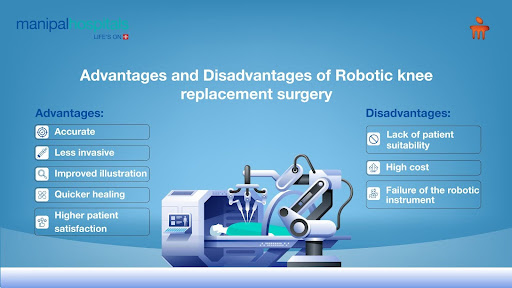Robotic Total Knee Replacement (TKR) creates a 3D model of the original knee to form a working image. It is intended to reduce errors related to bone cutting, prosthesis alignment, and positioning in orthopaedics. Compared to conventional TKR, robotic TKR yields superior surgical and clinical patient results. Over 12,800 surgeries have been carried out in the past 12 years with robotic help. This blog post discusses the advantages and disadvantages of robotic knee replacement, the technique, and the complications of the procedure.
Synopsis
About Knee Replacement Surgery
Robotic-assisted Knee Replacement Surgery involves the use of a robotic arm or system to guide the surgeon during the procedure. The robot helps with precise planning and execution, allowing the surgeon to make accurate cuts and position the implant with greater precision. To provide a longer prosthesis lifespan, robotic TKR was developed to increase bone preparation accuracy and reduce the likelihood of risks and complications. Patients undergoing Robotic Knee Replacement surgery are more compliant and recover more quickly than those who undergo traditional knee replacement surgery because of fewer difficulties. Consult our Orthopaedics Doctor in Bhubaneswar to receive the best knee treatment.
Types of Knee Replacement Surgery
There are different types of knee replacement surgery, and the choice of procedure will depend on the patient's specific condition and needs:
-
Total Knee Replacement (TKR): This involves replacing the entire knee joint with an artificial implant.
-
Partial Knee Replacement (PKR): This procedure replaces only a portion of the knee joint, leaving healthy parts of the joint intact.
-
Revision Knee Replacement: This is a secondary procedure performed to replace a previously implanted knee joint that may have failed or worn out.
Procedure
Robotic Knee Replacement surgery comes in various varieties:
-
Fully active: Perform every step of the femur and tibial bone resections.
-
Semi-active: Allows surgeons to do the procedure while providing input throughout the procedure to help regulate tibia and femur resection under the preoperative surgical plan.
The surgeon approaches and positions to safeguard the delicate tissues. Next, following the preoperative plan, the robotic TKR executes the bone resections. The surgeon can regulate the force and direction of the saw's movement. Some robotic TKR devices have software that allows two-dimensional knee X-rays to be converted into a three-dimensional bone model.
Pros of Robotic Assisted Knee Replacement Surgery
Already, robotic knee surgery has proven to be a successful medical procedure. The medical industry has profited in numerous ways:
-
Increased accuracy: Due to the robot's ability to precisely target incisions and angles, robotic knee support can be carried out with a high degree of accuracy.
-
Less Invasive: The robotic approach often requires smaller incisions, which can result in less scarring and a shorter hospital stay.
-
Improved illustration: During robotic knee replacement surgery, the patient's internal knee joint imaging is improved.
-
Aids in quicker healing: It can lead to a quicker recovery period in comparison to other surgical techniques.
-
Durational achievement ratio: Overall, patients have very high levels of satisfaction with robotic knee replacement surgery.
Cons of Robotic-Assisted Knee Replacement Surgery
The drawbacks include:
-
Failure of the mechanism: A patient's knee may be misaligned during robotic surgery due to a mechanical malfunction.
-
The surgery's cost: The robotic knee replacement operation is more expensive than the traditional method of knee replacement.
-
Patient Suitability: Robotic knee replacement may not be suitable for every patient. Surgeons may need to conduct additional assessments and tests to determine if it's the right choice for a specific patient.
Conclusion
Robotic knee surgery offers several advantages, including improved accuracy, a potential for faster recovery, and a more customised approach. However, there are also some drawbacks, such as cost and availability, that should be considered. As with any medical decision, it is important to discuss the options with your healthcare provider to determine the best approach for your specific needs.
At Manipal Hospitals, Bhubaneshwar, our orthopaedic specialists are experienced in both traditional and robotic-assisted knee replacement surgery. If you're considering knee replacement surgery, reach out to our Orthopaedics Hospital in Bhubaneswar to learn more about your options and receive personalised care tailored to your condition.
FAQ's
The capacity to carefully arrange the implant placement to best fit the patient's anatomy and achieve improved precision are the key advantages of robotic knee replacement surgery. This results in a less painful recovery period and a highly customised surgery experience. When there is a significant abnormality in the leg or knee, robotic knee replacement is particularly advantageous in difficult instances.
Patients usually need one to three months of physical therapy following a brief hospital stay to return to normal functionality, including pain-free walking.
Compared to traditional methods, you will experience less discomfort following a robotic knee replacement operation. This is because minimal knee exposure is required to do safe surgery. After all, the robotic arm bone cuts are so precise and prevent harm to the wrong structures.
When compared to traditional techniques, surgeons who employ robotic systems report that they improve precision, flexibility, and control throughout various surgeries and have a superior view of the surgical site.
To schedule an appointment at Manipal Hospitals, contact our hospital or visit our website.



















 4 Min Read
4 Min Read





10.png)




.png)




